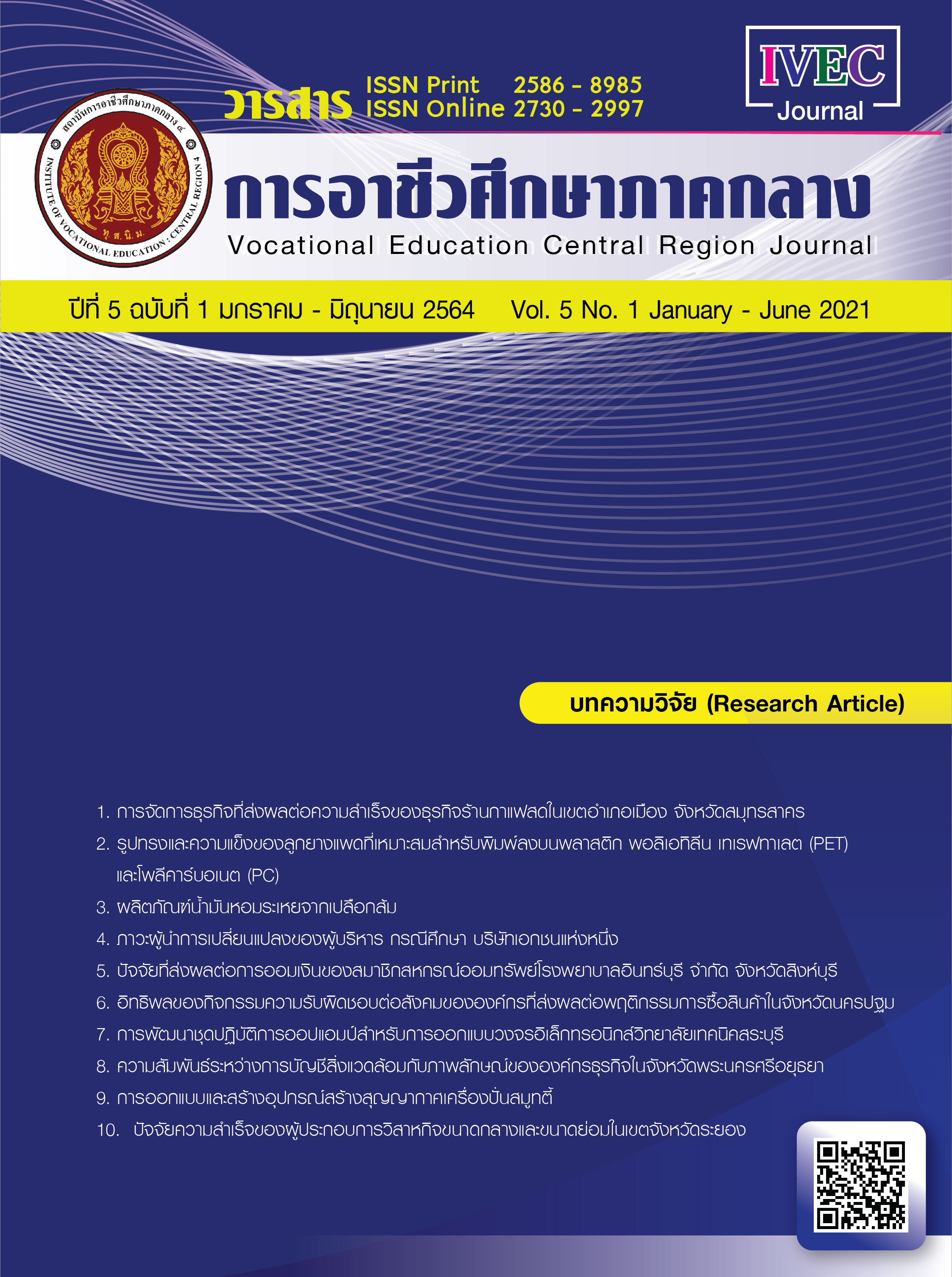Essential Oil Product from Orange Peel
Main Article Content
Abstract
The 5 objectives of this research were to: 1) study of essential oil extraction from orange peel using hot oil extraction 2) compare the amount of essential oil extraction from orange peel using different plant oils 3) compare the amount of essential oil obtained from different strains of orange peel 4) test the characteristics of essential oil from orange peel according to Thai SMEs standard and 5) study the users’ satisfaction of essential oil from orange peel by using 3 kinds; coconut oil, safflower oil and grape seed oil which is essential oil that is beneficial to the skin and is easy to find. In this research, there are 3 uses varieties of orange peel: Sai Nam Phueng, Shogun and Mandarin which is popular oranges that are eaten and easily available in the market.
The result of this research were as follows: 1) The hot oil extraction method used by the researcher can be used to extract essential oil from orange peel. Orange peel oil can be extracted by hot oil extraction. Dehydrated orange peel provides better oil quality than fresh orange peel in terms of oil, color and smell 2) Safflower oil is best extracted from the orange peel 3)Mandarin orange peel will give you the greatest amount of oil 4)Testing the characteristics of essential oil from orange peel according to Thai SMEs standard found that boiled the oil at 30 degrees Celsius for 24 hours and then homogeneous, non-separating, non-settling, free from foreign matter, regular orange color, good smell according to ingredients used, no musty, rancid or odors spoiled. Moreover, applied to the volunteers' abdomen and left for 6 hours, there was no redness, no irritation to the skin, and the pH of 5.0 was weak acid and 5) The users’ satisfactions toward the essential oil from orange peel was at high level terms of its scent, softness, smooth skin, the feeling of relaxation and the highest level of color and non-irritating properties.
Article Details
|
บทความ ข้อมูล เนื้อหา รูปภาพ ฯลฯ ที่ได้รับการตีพิมพ์ในวารสาร การอาชีวศึกษาภาคกลาง ถือเป็นลิขสิทธิ์ของวารสารการอาชีวศึกษาภาคกลางหากบุคคลหรือหน่วยงานใดต้องการนำทั้งหมดหรือส่วนใดส่วนหนึ่ง ไปเผยแพร่ต่อหรือเพื่อกระทำการใด ๆ กองบรรณาธิการไม่สงวนสิทธิ์ ในการคัดลอกบทความเพื่อการศึกษาแต่ให้อ้างอิงแหล่งที่มาให้ครบถ้วน สมบูรณ์ สงวนสิทธิ์ โดย สถาบันการอาชีวศึกษาภาคกลาง 4 ที่ตั้ง 90 ถนนเทศา ตำบลพระปฐมเจดีย์ อำเภอเมือง จังหวัดนครปฐม โทรศัพท์ 034 242 856 , โทรสาร 034 242 858 ISSN : 3056-9176 (print) ISSN : 2985-2382 (online) |
References
กระปุก. (2562). ประโยชน์ของเปลือกส้ม. ค้นเมื่อพฤศจิกายน 15, 2562, จาก https://health.kapook.com/view 198209.html
เคมีภัณฑ์. (2562). สารสกัดส้ม (เปลือก). ค้นเมื่อพฤศจิกายน 15, 2562, จาก https:// www.chemipan.com/a/th-th/
จีโอซิตี้. (2562). ลักษณะประจำพันธุ์ของส้ม. ค้นเมื่อ พฤศจิกายน 23, 2562, จาก http://www.geocities.ws/doiin/botany3.html
บุญชม ศรีสะอาด. (2560). การวิจัยเบื้องต้น. พิมพ์ครั้งที่ 10. กรุงเทพฯ: สุวิริยาสาส์น.
เมดไทย. (2562). สรรพคุณและประโยชน์ของส้ม. ค้นเมื่อ พฤศจิกายน 13, 2562, จาก https://medthai.com
ยูเซอริน. (2562). ค่า pH กับผิวหนังเกี่ยงข้องกัน อย่างไร. ค้นเมื่อ พฤศจิกายน 25, 2562, จาก https://www.eucerin.co.th/about-skin/basic-skin-knowledge/skins-ph
ศูนย์เครือข่ายข้อมูลอาหารครบวงจร. (2562). น้ำมันมะพร้าว. ค้นเมื่อ พฤศจิกายน 15, 2562, จาก http://www.foodnetworksolution.com
สัญชัย พันธโชติ, จิราภรณ์ ช่วงบัญญัติ, และทนงศักดิ์ สัสดีแพง. (2552). การสกัดน้ำมันหอมระเหยจากเปลือกส้มเกลี้ยง. รายงานวิจัยฉบับสมบูรณ์ สถาบันวิจัยและฝึกอบรมการเกษตรลำปาง มหาวิทยาลัยเทคโนโลยี ราชมงคลล้านนา.
สำนักงานมาตรฐานผลิตภัณฑ์อุตสาหกรรม. (2561). น้ำมันนวดตัวสำหรับสปา. กรุงเทพฯ: สำนักงานมาตรฐานผลิตภัณฑ์อุตสาหกรรม.


